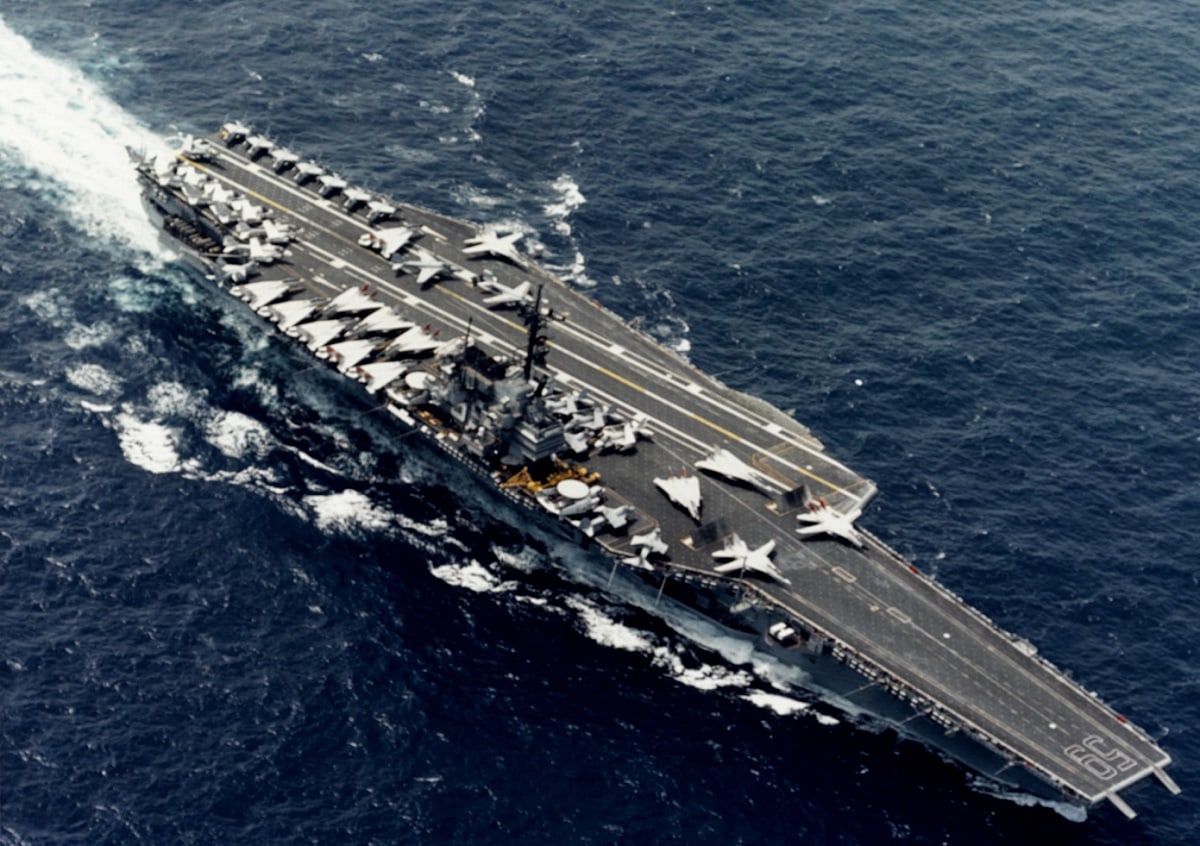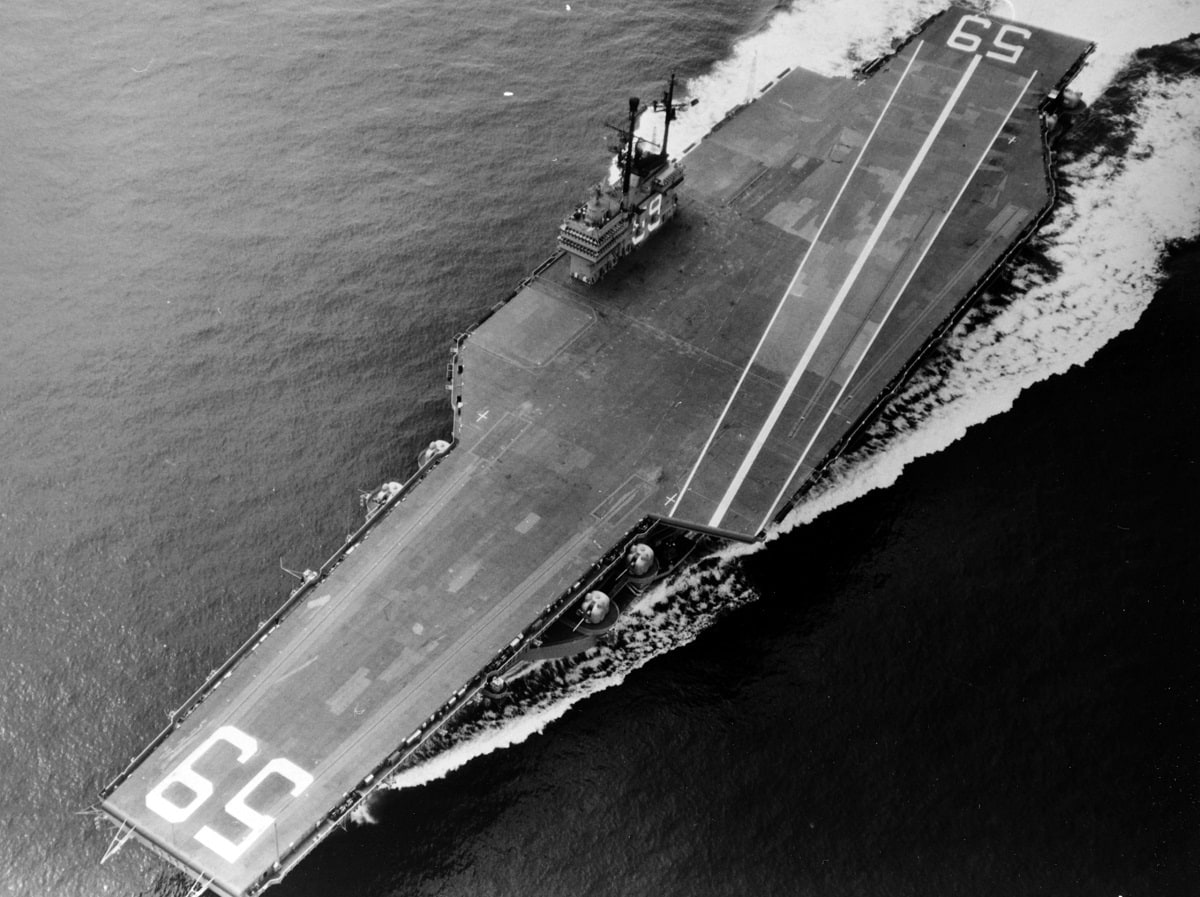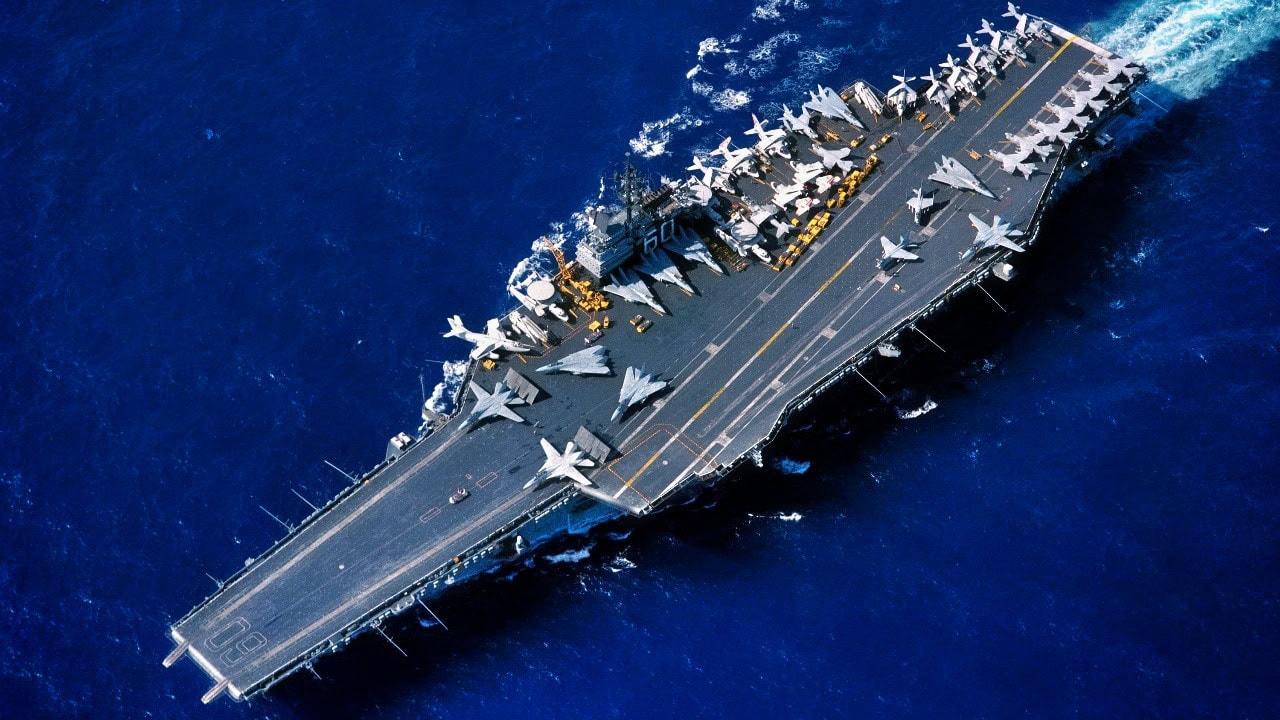Article Summary – USS Saratoga (CV-60) was the second Forrestal-class “supercarrier,” built to bring the Navy into the jet age with angled decks, steam catapults and a huge air wing.
-Commissioned in 1956, she spent most of her career with the Sixth Fleet, from early NATO exercises and the Lebanon crisis to Cold War standoffs in the Mediterranean.

USS Forrestal in 1987. Image: Creative Commons.

Forrestal undergoing sea trials, 29 September 1955
-Saratoga saw combat over Vietnam, struck Libya in 1986 and flew thousands of sorties during Desert Storm.
-After nearly four decades at sea and multiple modernizations, she was decommissioned in 1994 and, despite museum hopes, ultimately scrapped in 2019.
USS Saratoga Was a Masterpiece Aircraft Carrier
The USS Saratoga (CV-60) was one of many later models of Forrestal-class aircraft carriers.
The carriers were much larger than their predecessors in the class and were able to accommodate newer jet aircraft that were beginning to join the air wing. The Saratoga had a long and storied service history across many theaters before her eventual retirement in 1994, after the end of the Cold War.
She served in Vietnam and the Gulf War, in addition to numerous patrols to secure the safety of the seven seas.
Saratoga’s First Days
Work on the Saratoga began shortly after the cancellation of the USS United States (CVA-58) in 1949. The Navy then worked to develop a new class of carriers capable of handling jet aircraft. The Forrestal-class introduced the first “supercarriers,” designed from the keel up to accommodate heavier, faster jets and incorporate innovations such as angled flight decks and steam catapults. The Saratoga was the second ship of this improved class.
Her keel was laid on Dec. 16, 1952, at the New York Naval Shipyard in Brooklyn, and she was launched on Oct. 8, 1955. Commissioned on April 14, 1956, under the command of Captain Robert J. Stroh, the Saratoga cost approximately $209.7 million to build.
She was the first U.S. carrier to use high-pressure 1,200-psi boilers, powering four Westinghouse geared turbines that produced 280,000 shaft horsepower, enabling speeds of up to 35 knots. At 1,063 feet long and displacing more than 81,000 tons fully loaded, she could carry between 70 and 90 aircraft.
After her shakedown cruise to Guantanamo Bay in 1956, the Saratoga quickly became a fixture in U.S. naval operations. Her first major deployment was to the Norwegian Sea in 1957 for Operation Strikeback, a NATO exercise demonstrating Western resolve against Soviet expansion.
This marked the beginning of her long association with Sixth Fleet in the Mediterranean, where she spent much of her career. From 1958 onward, the Saratoga conducted annual Mediterranean cruises, supporting U.S. interests during crises such as the Lebanon intervention in 1958, when her aircraft provided cover for Marines landing near Beirut. These deployments underscored her role as a deterrent and rapid-response asset during the Cold War.
Service in Vietnam
The Saratoga’s angled flight deck allowed simultaneous launch and recovery of aircraft, a critical improvement for jet operations. She also featured steam catapults, advanced radar systems, and later upgrades such as the NATO Sea Sparrow missile system and Phalanx close-in weapon system for defense against modern threats.
These innovations kept her relevant as warfare evolved over the decades.
In April 1972, the Saratoga deployed to the Western Pacific to support U.S. operations during the Vietnam War. Her air wing flew hundreds of combat missions against North Vietnamese targets, earning the ship one battle star for her service.
This deployment marked her only major Pacific assignment, after which she returned to her familiar Mediterranean station.
Post Vietnam Patrols
Following the Vietnam War, the Saratoga underwent significant modernization during an 11-month overhaul in Philadelphia starting in 1968. She was reclassified from CVA-60 (Attack Aircraft Carrier) to CV-60 (Multi-purpose Aircraft Carrier) on June 30, 1972, reflecting her expanded mission set, which now included anti-submarine warfare and fleet air defense.
Throughout the 1970s and 1980s, the Saratoga remained a key player in Mediterranean operations. She hosted Presidents Dwight D. Eisenhower and Richard Nixon during high-profile demonstrations of U.S. naval power.
In 1986, the Saratoga was one of two carriers involved in strikes against Libya during Operation El Dorado Canyon, responding to state-sponsored terrorism. Her presence in the Mediterranean also served as a counterweight to Soviet naval forces, enforcing no-fly zones and participating in NATO exercises.
The Saratoga’s deployments projected American strength during some of the tensest periods of the Cold War.
Final Combat Outing and Retirement
The Saratoga’s final combat role came during the Gulf War in 1991. Operating from the Red Sea, she launched approximately 11,000 sorties against Iraqi targets, including air superiority missions, strikes on strategic installations, and support for coalition ground forces.
Despite a tragic ferry accident off Haifa that claimed the lives of several sailors, the Saratoga’s performance during Desert Storm was exemplary, cementing her legacy as a combat-proven carrier.
Like many large warships, the Saratoga experienced mishaps during her long career. In 1960, she collided with the German freighter Bernd Leonhardt off Virginia. In 1961, a machinery space fire killed seven crew members, and in 1964, a flight deck crash destroyed six aircraft.
These incidents highlighted the inherent risks of carrier operations but also the resilience of her crew and design.
The Saratoga earned numerous commendations, including two Navy Unit Commendations, three Meritorious Unit Commendations, one Battle Star for Vietnam, campaign ribbons for Southwest Asia and Armed Forces Expeditionary Medals.
After nearly 38 years of service, the Saratoga was decommissioned on Aug. 20, 1994, at Naval Station Mayport, Florida. Initially placed on donation hold for potential conversion into a museum, efforts to preserve her failed. In 2014, the Navy contracted ESCO Marine of Brownsville, Texas, to dismantle the ship for the symbolic price of one cent. Scrapping was completed by early 2019, marking the end of an era.
About the Author: Isaac Seitz
Isaac Seitz, a Defense Columnist, graduated from Patrick Henry College’s Strategic Intelligence and National Security program. He has also studied Russian at Middlebury Language Schools and has worked as an intelligence Analyst in the private sector.

